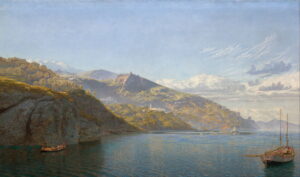Shipwreck paintings: 1 to 1850

In a couple of weeks time I will be commemorating the bicentenary of the death of Théodore Géricault, whose only well-known work is his vast Raft of the Medusa, the most famous painting of a shipwreck. This weekend I provide some context for his masterwork, with a selection of paintings showing shipwrecks.
Until the popularisation of air travel in the late twentieth century, there were only two options for many longer journeys: slowly and painfully overland with its attendant risks of murder by brigands, or by sea with its hazards of pirates and shipwreck. The remains of countless ships are now littered around the coasts of Europe, grim evidence of just how many voyages never reached their destination. Here are a few that set out but didn’t return.
Jacopo Tintoretto (c 1518-1594), St Mark Rescues a Saracen (E&I 98) (1562-66), oil on canvas, 398 x 337 cm, Gallerie dell’Accademia, Venice, Italy. Image by Didier Descouens, via Wikimedia Commons.
Tintoretto’s St Mark Rescues a Saracen is a stormy nocturne showing a story from the Golden Legend, in which Saint Mark is claimed to have saved a ‘Saracen’ (an Arab) from drowning in a shipwreck, as he had made a vow that if so rescued, he would be baptised as a Christian. After his rescue, the Saracen failed to meet his promise, so Saint Mark appeared and reminded him of his vow, and the Saracen went to Venice and was baptised in the saint’s name.
Alessandro Magnasco (1667–1749), Landscape with Stormy Sea (c 1718-25), oil on canvas, 93 x 130 cm, National Museum of Western Art, Tokyo. Wikimedia Commons.
By the early eighteenth century, landscape artists were starting to paint views of the coast during storms, such as Alessandro Magnasco’s Landscape with Stormy Sea, which was painted between 1718-25. Born and resident in Genoa, he would have been only too familiar with the storms of the Mediterranean, and their short, steep seas, just as he showed here.
Claude Joseph Vernet (1714–1789), A Storm on a Mediterranean Coast (1767), oil on canvas, 113 × 145.7 cm, J. Paul Getty Museum, Los Angeles, CA. Wikimedia Commons.
Claude Vernet’s A Storm on a Mediterranean Coast (1767) combines a wrecking with keenly-observed signs of the weather, including the coincidence of reflected and oncoming waves just off its small beach, and the trees at the upper left. Although this was painted in the studio, Vernet probably worked from sketches he had made during storms.
Francisco Goya (1746–1828), The Shipwreck (1793-94), oil on tinplate, 50 × 23 cm, Bowes Museum, Barnard Castle, England. Wikimedia Commons.
Although it has been suggested that Goya’s Shipwreck (1793-94) might show the Biblical flood, the breaking waves and rocky coastline make it most likely to show survivors coming ashore from a stricken vessel, and this is confirmed by a couple of barrels as flotsam to the left. Although Goya spent much of his life inland, he had also travelled by sea, and must have been familiar with many stories of shipwreck.
Francis Wheatley (1747–1801), The Rescue of Aemilia from the Shipwreck (c 1795), further details not known. Wikimedia Commons.
Francis Wheatley’s The Rescue of Aemilia from the Shipwreck from 1795 shows two fishermen rescuing a mother and her twin infants into their boat. This forms part of the opening scenes of William Shakespeare’s play The Comedy of Errors, and sets up the main plot with its identical twins.
Jean Louis Théodore Géricault (1791–1824), The Raft of the Medusa (1818-19), oil on canvas, 491 x 716 cm, Musée du Louvre, Paris. Wikimedia Commons.
I will write at greater length of Théodore Géricault’s masterwork The Raft of the Medusa (1818-19). This vast canvas with its life-sized figures has had huge impact on everyone who has seen it since 1819. Its relatively traditional approach and attention to detail give it the air of complete authenticity, although Géricault carefully manipulated its composition in several ways to make his point. For example, he shows the few survivors crowded together on a small part of the raft, and crops the image tightly to give the impression that the raft was overcrowded, which it wasn’t.
Joseph Mallord William Turner (1775–1851), Wreckers – Coast of Northumberland, with a Steam-Boat Assisting a Ship off Shore (1833-4), oil on canvas, 122.6 x 153 cm, Yale Center for British Art, New Haven, CT. Wikimedia Commons.
Late in his career, JMW Turner painted several radical views of storms at sea. His Wreckers – Coast of Northumberland, with a Steam-Boat Assisting a Ship off Shore from 1833-34 shows a sailing ship in distress near Dunstanburgh Castle in a storm. The implication in the title is that the people in the foreground are salvaging cargo from the beach; whether they also played a role in luring the vessel onto the rocks isn’t clear.
Eugène Lepoittevin (1806-1870), Shipwrecked (1839), media and dimensions not known, Musée de Picardie, Amiens, France. Image by Grégory Lejeune, via Wikimedia Commons.
Eugène Lepoittevin’s Shipwrecked from 1839 shows the surviving crew of a ship that has struck an iceberg in the Arctic. The sailor standing, wearing a red jacket, is fending off a polar bear, one of four in the water to the right.
With Géricault as his mentor and close friend, it was only to be expected that Eugène Delacroix became obsessed with shipwrecks. As a student at the time that Géricault was painting The Raft of the Medusa, Delacroix had also been one of the models.
Eugène Delacroix (1798–1863), Shipwreck of Don Juan (1840), oil on canvas, 135 x 196 cm, Musée du Louvre, Paris. Wikimedia Commons.
Delacroix’s Shipwreck of Don Juan (1840) is taken from the second canto of Byron’s poem Don Juan. In this, Don Juan and his shipwrecked companions run out of food, then draw lots to determine who will be sacrificed to feed the other survivors.
Eugène Delacroix (1798–1863), Castaways in a Ship’s Boat (c 1840-47), oil on canvas, 36 x 57 cm, Pushkin Museum of Fine Arts Государственный музей изобразительных искусств имени А. С. Пушкина, Moscow, Russia. Wikimedia Commons.
At some time prior to the Salon of 1847, Delacroix revisited the shipwreck of the Don Juan in his Castaways in a Ship’s Boat (c 1840-47). The number of survivors is falling.




